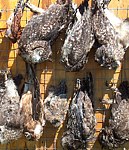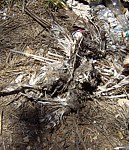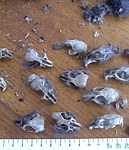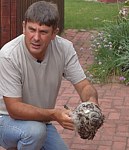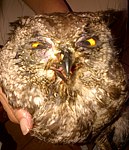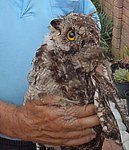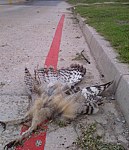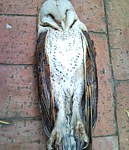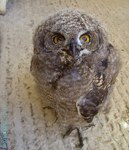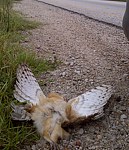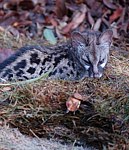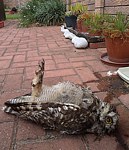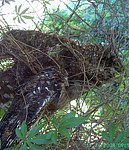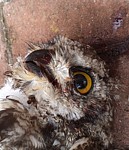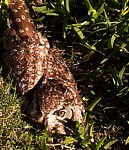Secondary Poisoning of Raptors.
The affect of Port Elizabeth’s ‘rat plague’ on urban raptors - CLICK HERE
There is no such thing as a raptor-friendly rat poison - CLICK HERE
The affect of Port Elizabeth’s ‘rat plague’ on urban raptors
The rat plague in Central story featured on the front page of the Herald of 29 January 2007 oversimplifies a major problem facing the human race. Contrary to statements that the rat problem seems to emanate from the rundown Central area and then extend outwards, the whole city and its suburbs are rodent infested, as a matter of fact so is every city in the world.
Two exotic species are resident, Brown and Black or Roof and Norwegian [house] rats if you prefer. Roof rats are the dominant species in our areas, being the hardest to poison due to their arboreal lifestyle. House rats have adapted to a boreal existence and are not as capable climbers as roof rats.
Male rats of both species forage for up to one kilometre from where they live.
A single pair of rats can generate 15 000 offspring in their lifetime.
Both species occur in Central. Although derelict buildings are good breeding areas rodents need a good steady supply of quality food to breed. This source of food comes from restaurants, grocery stores and food warehouses and domestic residences. Drunken vagrants don’t throw food around.
Our wasteful habits have helped these urban survivors, breed us right out of our own homes and they are the new urban wildlife, occupying their own ecological city niche.
Thanks to poisons our indigenous allies, house snakes, barn and spotted eagle owls and rock kestrels have been virtually poisoned out of existence in the urban areas.
Active spotted eagle owl nest sites in the urban areas dropped from 23 in 2001, to 4 in 2006 with only 3 being destroyed as a result of development. In the rest of the deserted nest sites the birds just “disappeared “.
In 2004 48 barn owl chicks came in from destroyed urban nesting sites.
In 2001 Poisoning accounted for 15% of spotted eagle owls brought in to Wildline, collisions with vehicles 18% and the rest were nestlings.
By 2006 Poisoning accounted for almost 60%, of spotted eagle owls brought in to Wildline, vehicles 7% and the rest were nestlings.
In the month of November 2006 alone we received 23 poisoned raptors from the metro area including booted eagles, wood owls, rock kestrels and spotted eagle owls, only two survived .In December 07 I was called to collect a poisoned owl from the bottom of Walker drive in Sherwood, one of a resident pair nesting there. I went to their nest both sub-adult chicks were dead and the other bird has also disappeared. The poisoned owl died two days later. Why? The new Shopping center development on the corner has a large food wholesaler poisoning rodents who are already infesting the area.
We’re already at ‘Superwarfarin level” but still rats are beating us, becoming immune to new poisons as fast as they’re being developed. Unfortunately it’s those rodents that carry lethal doses around with them that kill our indigenous urban predators.
I have personally live-trapped and sampled literally hundreds of these rodents in food warehouses. Rats are far too intelligent to eat poisons “willy-nilly” when food is freely available. Poison greases applied by pest controllers to rat walkways are probably the most effective control measure, albeit absolutely deadly to raptors.
Using poisons is an easy way out of a problem exacerbated by our wasteful society. We should rather be looking at alternatives including attracting raptors back into our urban areas and better waste management. I have used owls to control rodents in warehouses and stores with great success.
On the subject of rat-borne disease:
Rats have been identified as carrying over 70 diseases known to affect man and to quote the WHO “Rats are the biggest health time bomb facing the human race”.
Residents of cities are a newly identified population at risk for a bacterial disease carried by rats according to a Nov. 15 Annals of Internal Medicine study led by Joseph M. Vinetz, M.D., a postdoctoral fellow in the National Institute of Allergy and Infectious Diseases (NIAD)"Our results suggest that leptospirosis may be yet another re-emerging infectious disease in urban United States," he and his co-authors conclude.
"Leptospirosis may be the most common disease that rats carry and transmit to humans in the United States," comments Dr.Vinetz, "but it's simply under recognized." Although leptospirosis is not new to the United States, it is difficult to diagnose, hence its prevalence is unknown.
As a matter of interest I have only ever trapped one indigenous rodent, a striped field mouse, inside a warehouse.
In this past week we received 3 poisoned spotted eagle owls and a poisoned grass owl, from within the Metro area. This brings the total of poisoned raptors to 46 in 4 months, just from the urban areas.

CLICK HERE TO LAUNCH PODCAST(17.5MB MP3)
There is no such thing as a raptor-friendly rat poison
“As crude a weapon as the cave man’s club, the chemical barrage has been hurled against the fabric of life.” - Rachel Carson, Silent Spring 1962
There have been numerous articles written on our local rat plague, which is actually a world-wide phenomenon. Unfortunately, as Rachel Carson put it ‘the chemical barrage’ has grown ever bigger, ever deadlier without really stemming problem rodent numbers.
An example is the City of Cape Town where commercial pest control operators are laying down an average of 12 ton of rodenticides a month. Add to this what the private homeowners and municipal authorities are putting out and the mind boggles.
Worldwide thousands of predators are dying from secondary poisoning by eating functioning poisoned rodents whose poison tolerance levels are continuously evolving.
In Planter 60 (1) 1984: 3-11 (Kuala Lumpur) Duckett informed that, in a period of 2 years, 38 of the 40 Barn Owls present on a Malaysian plantation died of rodenticide poisoning.
According to Bowles in Environmental News Network of January 1999 the number of Barn Owls in England with anticoagulant rodenticide poisoning has increased from 5% in 1983-84 to 36% in 1995-96.
In his paper "Rodenticide effects on British Barn Owls" (a contribution to The Owls 2000 conference in January 2000, Canberra, Australia) Professor Ian Newton (e-mail: i.newton@ite.ac.uk) describes a programme to monitor the levels of rodenticides in Barn Owls in Britain, and assess the effects on populations. On www.tasweb.com.au/owls2000 he further writes: "the fact that rats and mice in many parts of the world have become genetically resistant to Warfarin and other 'first generation' rodenticides has stimulated chemical companies to develop new 'second generation' compounds for use in rodent control. The new compounds are more toxic and more persistent than the old ones.
Poison threat to rare barn owls
Monday, February 04, 2008 - By Linda McKee [Belfast Herald]
Barn owls are hurtling towards extinction in Northern Ireland, with numbers plummeting to as low as 45 pairs. It's thought that the species has declined by around 80% in the last 40 years - and intensive farming and rat poison are the culprits.
And Gerald W. Winegrad, vice president of policy at the American Bird Conservancy, noted that more than 250 animals have died locally after ingesting rat poison. They include endangered San Joaquin Valley kit foxes of California, golden eagles, great horned owls, mountain lions and bobcats.
“Rodenticides are designed to kill. Treat any statement that products can be "safely" used with caution.” (Barn Owl Trust, United Kingdom)
“Raptors & Rodenticides: A Deadly Combination
THERE IS NO SAFE RAT POISON! Do not take the word of pest control operators - do your own research by looking up the Material Data Sheets for the active ingredient in any pesticide or rodenticide that a pest control company recommends! Californians for Alternatives to Toxics. [CATS]”
In South Africa a multiple feed rodenticide claims to be“raptor friendly”. This bold statement is gleefully used by pest control operators to justify their efforts as “environmentally friendly”.
So let us take a look at this product:
• Handle with care.
• Poisonous when swallowed.
• Toxic to fish, wildlife, pigs and other domestic animals.
• Store away from food and feedstuffs.
• Keep out of reach of children, pets, poultry and livestock.
This is the manufacturer’s own warning so what is the “raptor friendliness” of the product? This is based on the supposition that the rodent has to feed a number of times on the poison bait and does not carry a large dose of poison, as would be obtained from from feeding on a single kill poison.
• The problem is that rodents often develop “bait shyness” so they stop feeding on the poison rendering it in-effective and at the same time bolstering their own immunity to the product.
• Certain poisons that are deadly to birds can safely be used on mammals. On how many raptors has this product been tested, to determine the effect that Coumatetralyl, the active ingredient, has on birds?
• Worldwide poison manufacturers are being taken to task, but in this country they have been the sponsors of organizations who have tasked themselves with protecting our indigenous wildlife. I personally have received numerous reports of the poisoning of raptors but there seems to be, excuse the pun a “deathly silence” from these organizations. This particularly so in the case of the secondary poisoning of predators by rodenticides.
• Has any one even taken into account that these rodenticides are deadly to our indigenous non-problem rodents, some who are endangered?
“According to Tim Snow, [Endangered Wildlife Trust's chief of field staff], owl boxes are the answer here." An owl catches something like 14 000 rodents [should be 1400] a year. You'll have a permanent, resident rodent-control service," he says.”
This article was originally published on page 10 of The Star on March 27, 2008
A pleasant change from their original stance?
"I stick by my informed personal view that there is no such thing as a raptor-friendly rat poison. This is a view-point shared by hundreds of informed environmental agencies worldwide." - Arnold Slabbert
Welcome to our world…..please use the contact form to drop us a line & we will contact you.



